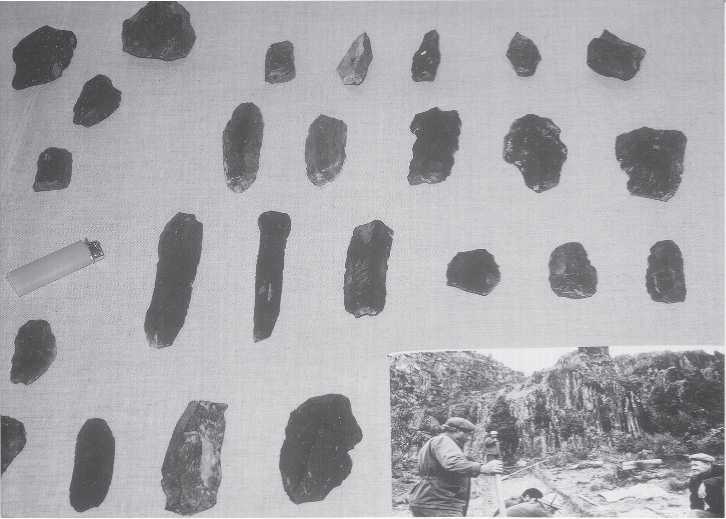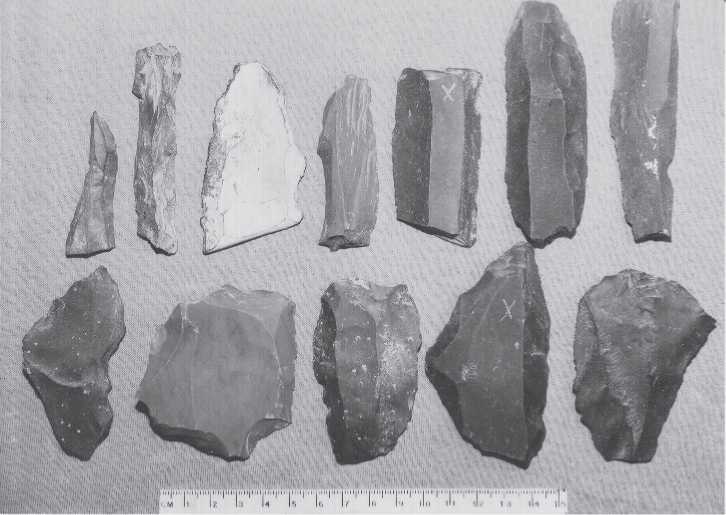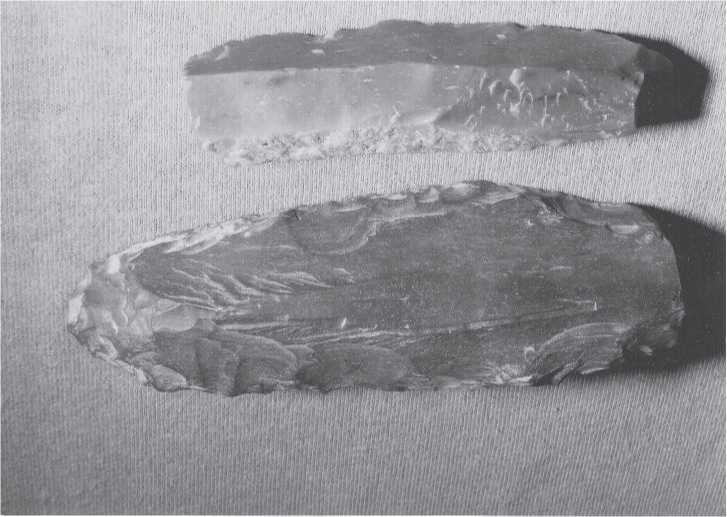1 Provenience. The 108 Kara-Bom pieces make up 1.2% of the 8813-piece grand total of this study (Table A1.1, site 10). Because this is a very old open site, with poor

Fig. 3.44 Kara-Bom artifacts. An exhibit in the former IHPP museum shows some of the stone artifacts found at Kara-Bom. The exhibit photograph shows Okladnikov directing the excavation in 1980 of the open workshop that was believed to be 30 000-40 000 years old. Faunal remains, including those of cave hyenas, came from a largely disturbed part of the site. Butane lighter is 9.0 cm long (CGT color IHPP 2-10-84:1).

Fig. 3.45 Kara-Bom artifacts. Both flake and blade objects were found at this open workshop site. Scale is 15 cm (CGT neg. IAE 7-30-03:37).

Fig. 3.46 Kara-Bom blade artifacts. Both objects are knife-like in shape, but only the larger one has any retouching. The larger specimen is 11.6 cm long; shorter one is 8.5 cm (CGT neg.
IAE 7-30-03:33).
Preservation, we assume that our bone sample dates to the more recent part of the human use of the site.
2 Species. The most common groups in the 108 Kara-Bom pieces are: indeterminable (45.4%), big mammal (23.1%), marmot (11.1%), medium mammal (6.5%), and hare (3.7%) (Table A1.2, site 10). Big and very big animals, including bison, horse, hyena, mammoth, and rhinoceros, are also represented, but in very low frequencies. Because their big bones are more likely to be preserved than those of smaller animals, we doubt whether the marmots and hares are actually of Pleistocene age. Compared with the pooled assemblage averages, Kara-Bom has no bear, goat-sheep, reindeer, or roe deer; fewer horse and mammoth; and more big mammal, marmot, medium mammal, and indeterminable.
3 Skeletal elements. Out of 108 Kara-Bom pieces, the most common skeletal elements are: unknown (25.9%), long bone (25.9%), rib (11.1%), toe (6.5%), mandible (4.6%), and vertebra (3.7%) (Table A1.3, site 10). Compared with the pooled assemblage averages, Kara-Bom has more ribs, long bones, unknowns, and no scapulae.
4 Age. Out of 108 Kara-Bom pieces, there is only a 1.8% sub-adult representation (Table A1.4, site 10). Compared with the pooled assemblage average, Kara-Bom has fewer sub-adults.
5 Completeness. Among Kara-Bom’s 108-piece assemblage, there are 8.3% whole bones, 25.9% with one anatomical end, and 65.7% without any anatomical end (Table A1.5, site 10). These frequencies are similar to those of the pooled assemblage.
6 Maximum size. Postmortem breakage limited the Kara-Bom sample for size measurement to 24 pieces. Of these, the mean is 6.6 cm, the range is 3.0 cm to 24.8 cm (Table A1.6, site 10). Compared with the pooled assemblage values, both the mean and range in Kara-Bom are slightly lower. The limited species information precludes making any meaningful comparisons with Vera Gromova’s (1950: table 27) whole long bone length measurements.
7 Damage shape. The most common types of damage in the 108 Kara-Bom pieces are: long bone flakes (37.0%), long bone fragments (17.5%), long bone splinters (9.3%), mostly whole (9.2%), undamaged (7.4%), medial ribs (5.5%), and phalanx butts (3.7%) (Table A1.7 site 10). Compared with the pooled assemblage averages, Kara-Bom has more long bone flakes, long bone splinters, and mostly whole; and fewer long fragments.
8 Color. Most of the Kara-Bom pieces are ivory colored (102/108; 94.4%), and only 5.6% are brown (Table A1.8, site 10). There are no black (burned) pieces. Compared with the pooled assemblage, Kara-Bom has more ivory colored pieces, and fewer of the other colors.
9 Preservation. As expected for an open site, Kara-Bom has many chalky pieces -32.4%ofthe 108 (Table A1.9, site 10). This frequency is almost twice that of the pooled assemblage average. The most similar of the open sites are Malaya Seeya (15.3% chalky pieces) and Mal’ta (50.0% chalky).
10 Perimortem breakage. Kara-Bom has 88.3% perimortem breakage (91 /103 pieces) (Table A1.10, site 10). This frequency is close to the pooled assemblage average.
11 Postmortem breakage. Rather like other open sites, Kara-Bom has a relatively frequent occurrence of postmortem breakage (28/106; 26.4%) (Table A1.11, site 10). As expected, this frequency is greater than the pooled assemblage average.
12 End-hollowing. Only 42 Kara-Bom pieces could be assessed for end-hollowing, which occurs in 4.8% of the set (Table A1.12, site 10). This frequency is about half that of the pooled assemblage average. Nevertheless, it helps document the presence of carnivores.
13 Notching. Almost identical to above, the frequency of Kara-Bom notching is 4.7% in 106 pieces (Table A1.13, site 10). Each has only one notch. Compared with the pooled assemblage average, Kara-Bom has about three times less notching.
14 Tooth scratches. This indicator of carnivore activity is present in 10.9% of 92 Kara Bom pieces (Table A1.14, site 10). The number of scratches per piece ranges fTom one to more than seven. Compared with the pooled assemblage average, Kara-Bom has about half the frequency of tooth scratching.
15 Tooth dints. Of 89 pieces that could be assessed for dinting, 7.9% have fTom one to more than seven dints per piece (Table A1.15, site 10). The pooled assemblage average is about three times greater.
16 Pseudo-cuts. No example of pseudo-cutting was identified in 90 Kara-Bom pieces (Table A1.16, site 10).
17 Abrasions. Out of 90 Kara-Bom pieces, one (1.1%) has six abrasion grooves (Table A1.17, site 10). The very low frequency is almost identical to the pooled assemblage average.
18 Polishing. There is 75.8% polishing in 99 Kara-Bom pieces. These are located on the end (7.1%), middle (2.0%) and end-middle (66.7%) (Table A1.18, site 10). The amount of polishing in the pooled assemblage average is not much different, although there is more end-polishing than in Kara-Bom.
19 Embedded fragments. Out of 105 Kara-Bom pieces, 2.9% have one embedded fragment each (Table A1.19, site 10). The frequency of embedding in the pooled assemblage average is very similar, although multiple embedded fragments up to more than seven do occur.
20 Tooth wear. Kara-Bom has only five teeth to use for evaluating tooth wear. Of these, two (40%) suggest young individuals (Table A1.20, site 10). This value is much like the pooled assemblage average for young individual occurrence.
21 Acid erosion. Out of 105 Kara-Bom pieces, 6.7% have acid erosion (Table A1.21, site 10). This is about the same as the pooled assemblage average (5.9%), and similar to the Razboinich’ya hyena cave acid erosion frequency (7.3%). As we have pointed out previously, the evidence for hyena presence should serve as a warning that stratigraphic disturbances might have taken place as a consequence of the digging and burrowing behavior of these large scavenging and hunting animals.
22 Rodent gnawing. One of the 104 Kara-Bom pieces shows rodent gnawing (1.0%) (Table A1.22, site 10). This rare occurrence is nearly the same as the pooled assemblage average.
There are no examples of these variables in 104
23-24 Insect damage and human bone.
Kara-Bom pieces.
25 Cut marks. Out of 89 Kara-Bom pieces, 4.5% have cut marks. These range fTom one to more than seven cuts per piece (Table A1.25, site 10). The pooled assemblage average is slightly greater. Given the nearby availability of stone that would readily allow blade tool production, we considered whether cut marks at Kara-Bom might differ in some manner compared to those found at sites where flakes were the primary cutting tool. Using a x20 hand lens, we could see no differences, at least none as apparent as cut marks produced with obsidian blades compared with other less glassy stone types.
26 Chop marks. Chop marks in 89 Kara-Bom pieces are slightly more frequent than cut marks, at 6.7%. The number of chop marks also range from one to more than seven per piece (Table A1.26, site 10). The pooled assemblage average is nearly the same.




 World History
World History









